Disclaimer: This thread is not a debate over which solution is best for proactively solving the lifter/cam issue. This is meant to help those who wish to replace their oil pump with one for a Hellcat/SRT, as there are some sticky situations to be mindful of.
For those who haven’t heard about the Hellcat oil pump, it’s circulating as a potential solution for preventing the lifters and cam failing (the dreaded hemi tick.) It is said to be due to the lifters being of poor build quality, or the MDS system causing it. However, the lifters have failed for some folks who did an MDS delete with non-MDS lifters. You may develop a lifter failure at any time, or you may never develop one at all. I personally don’t ever want the chance to deal with that headache, so I started researching. And yes, aftermarket lifters are of higher quality such as Comp Cams or Melling. Modern Muscle Extreme did a comparison video of different lifters and their ability to hold oil. It is speculated that it may also be due to a camshaft hardening issue combined with insufficient lubrication, causing the lifters to fail and beat on the cam.
Hemis with high idle times are the most likely to develop a lifter/cam issue. Police cars and commercial trucks especially. At idle, your oil pressure is sustained at the lowest it will be. It is theoretically likely that the idling oil pressure at operating temperature is not sufficient for longevity’s sake.
To increase oil pressure at idle you can increase your idle RPM with a tuner, change to thicker oil (but am unsure how much it would increase by), and/or upgrade to a Hellcat oil pump. I opted for the latter. The Hellcat pump has bigger rotors than the 5.7L, pushing a higher volume of oil.
It is a very laborious job. I only tackled it because I had very experienced help to guide me and catch me if I fell. I hope to give those who wish to take on this task any advice I can that I believe would be of use.
For the job, here is a list of parts needed. This does not include specialty tools.
*Hellcat Oil Pump
68195993AD
*Oil Pump Pickup Tube O-Ring
53020861
*Crankshaft Oil Seal
53021585AD
*Timing Cover Gasket
53021521AD
*Water Pump Gasket
68391488AA
*50/50 Antifreeze/Coolant (2-3 gallons)
68163849AB
*Engine oil and oil filter of your choice
I’m using Valvoline 5W-20 for now, with an SRT oil filter (5038041AA). This filter is of a superior design (designed by SRT for the Viper) and is good for about 3 more PSI of oil pressure.
*A/C Recharge of R-1234yf
Very expensive, good luck finding a reasonably priced bottle. 5th gens take 18 ounces (510 grams) but you can get away with less.
*Optional* Mopar Oil Pan Gasket
53021568AE
Steps:
Disconnect your negative AND positive battery terminals. You don’t want the possibility of your alternator lighting you up when you go to disconnect it.
Drain the radiator, drain the engine oil, change your oil filter, and release the lovely toxic gases out of your A/C condenser.
Remove your cold air intake, grille, fan, active grille shutter, radiator, A/C condenser, coolant reservoir and windshield washer fluid bottle. Remove one headlight so you can remove the radiator support. Now you have plenty of room to work.
Take pictures of everything as you go along so you can always refer back to them for when you reassemble.
Remove your drive belt, alternator, brake booster vacuum pump, and A/C compressor. The A/C compressor isn’t bolted in with standard bolts, they are very long studs.
Remove your vibration damper.
With a sharpie, number every bolt head on the timing cover and water pump. There are several different lengths so if you don’t want to go through trial and error when putting them back on, number them.
Remove the water pump. Prepare for some coolant.
Remove the timing cover. You are now looking at your cam sprocket, timing chain and oil pump. If you want to do a cam, now is the time.
The oil pump is held in with four horizontal bolts for the body of the pump and one vertical bolt for the oil pickup tube. The oil pickup tube is your problem child, as you have very little space to work with due to the oil pan. Remove the four easy bolts first. You can now ever so slightly tilt the oil pump side to side. On the truck hemis, the pickup tube is also bolted into the oil pan gasket/integrated windage tray. If you have a 5.7 in a car you can rotate the oil pump a little further as they do not have the bolt in the windage tray.
At this point, in order to get the bolt for the pickup tube off you have two options. The proper way is to remove the oil pan and unbolt the pickup tube from below. If you have 4wd your front diff is 100% in the way and that would have to be dropped to remove the oil pan-- or you hoist the engine up enough to clear the pan. I’m not sure how much room there is with 2wd trucks.
Your other option, although more risky, is to remove all of the accessible oil pan bolts and use a pry bar as a WEDGE at the front. NOT to pry down (except for the initial step to get a pry bar between the pan and engine.) See picture below. Remove as many oil pan bolts as you can see to ease on the pressure of the sides of the oil pan gasket when you crack the seal to insert your wedges. I don’t recommend doing this method if your oil pan gasket is not new, (older than 5 years) or if you have a lot of miles on your truck. The gasket is badass and has no problem resealing if in good shape.
Below the oil pump are two openings in the windage tray. Stuff a rag in the driver side hole completely to prevent anything from falling in there. On the passenger side where your pickup tube bolt is, stuff a rag in there and make a little bowl. That way if your bolt drops you can take it out.
With your rags and pry bars in place, you have enough room to fit a 13mm wrench in to break the bolt loose. A ratchet wrench won’t work because you don’t have enough room to remove the wrench once the bolt is loosened further. Dry the bolt head as best you can with a rag.
With your best stick magnet, glide it over the bolt head to help loosen it far enough to where you can use your fingers to remove it entirely.
You can now remove the oil pump. It must be lifted upward and outward to clear the lip of the pickup tube. Change the o-ring on the pickup tube.
Get out your new beautiful and shiny Hellcat pump. Pour some fresh oil down the pickup tube of the pump and move the rotors around to lube it up. Drain out excess.
Installing the pump is a little tricky as you have to be careful sliding it down your crankshaft and clearing the pickup tube lip. Do NOT force anything. Once the oil pump rotors are aligned with the crank it will slide right on, you will just have to play with it some to clear the pickup tube.
Put your pickup tube bolt back in and start the threads by hand. You can sand/scuff the sides of the bolt head for some extra grip. Use your stick magnet to tighten the bolt, then use your 13mm wrench to snug it back up. Reinstall the four oil pump mounting bolts and torque to 21 ft lbs.
Remove your pry bars/wedges.
Prep your timing cover and water pump by cleaning the surface where the gaskets were. Give extra effort to clean the bottom of the timing cover. That part of the oil pan gasket is given a line of sealant from the factory. It will stick to your timing cover, and it should be cleaned off entirely. A wire brush worked best for me.
Install your new crankshaft seal on your timing cover. Do not lube it up with oil beforehand or else it will leak. Tap it in dry carefully. Install your new timing cover and water pump gaskets. Take note as to how the old gaskets are oriented.
Apply some RTV sealant between the block and gasket (where your pry bars were resting) and also on the face of the gasket directly in front of that.
Install your timing cover and water pump. All bolts are torqued to 21 ft lbs.
Install your vibration damper/crankshaft bolt. Torque to 130 ft lbs.
Reinstall all your accessories back onto your timing cover, then your drivebelt. I’m glad I took a picture of the belt before I removed it so I could figure out how to put it back on.
Reassemble your truck in reverse order and replenish your fluids. I bought four gallons of coolant but I only ended up using two full gallons. Refill your engine with oil. Recharge your A/C.
Reconnect your battery and start ‘er up!
Oil pressure at startup while cold is 80-85psi
Idle at operating temperature fluctuates between 34-36psi
Normal driving conditions between 60-70psi
WOT is 75-80psi
After a test drive be sure to thoroughly inspect for leaks. If you broke the oil pan seal, get under the truck and look at both sides of your oil pan for signs of any drippage. I personally have had ZERO issues.
Overall very pleased with the results.
In my opinion, compared to engines of the old days, this high-volume pump could be an oldschool solution to a modern problem.
For those who haven’t heard about the Hellcat oil pump, it’s circulating as a potential solution for preventing the lifters and cam failing (the dreaded hemi tick.) It is said to be due to the lifters being of poor build quality, or the MDS system causing it. However, the lifters have failed for some folks who did an MDS delete with non-MDS lifters. You may develop a lifter failure at any time, or you may never develop one at all. I personally don’t ever want the chance to deal with that headache, so I started researching. And yes, aftermarket lifters are of higher quality such as Comp Cams or Melling. Modern Muscle Extreme did a comparison video of different lifters and their ability to hold oil. It is speculated that it may also be due to a camshaft hardening issue combined with insufficient lubrication, causing the lifters to fail and beat on the cam.
Hemis with high idle times are the most likely to develop a lifter/cam issue. Police cars and commercial trucks especially. At idle, your oil pressure is sustained at the lowest it will be. It is theoretically likely that the idling oil pressure at operating temperature is not sufficient for longevity’s sake.
To increase oil pressure at idle you can increase your idle RPM with a tuner, change to thicker oil (but am unsure how much it would increase by), and/or upgrade to a Hellcat oil pump. I opted for the latter. The Hellcat pump has bigger rotors than the 5.7L, pushing a higher volume of oil.
It is a very laborious job. I only tackled it because I had very experienced help to guide me and catch me if I fell. I hope to give those who wish to take on this task any advice I can that I believe would be of use.
For the job, here is a list of parts needed. This does not include specialty tools.
*Hellcat Oil Pump
68195993AD
*Oil Pump Pickup Tube O-Ring
53020861
*Crankshaft Oil Seal
53021585AD
*Timing Cover Gasket
53021521AD
*Water Pump Gasket
68391488AA
*50/50 Antifreeze/Coolant (2-3 gallons)
68163849AB
*Engine oil and oil filter of your choice
I’m using Valvoline 5W-20 for now, with an SRT oil filter (5038041AA). This filter is of a superior design (designed by SRT for the Viper) and is good for about 3 more PSI of oil pressure.
*A/C Recharge of R-1234yf
Very expensive, good luck finding a reasonably priced bottle. 5th gens take 18 ounces (510 grams) but you can get away with less.
*Optional* Mopar Oil Pan Gasket
53021568AE
Steps:
Disconnect your negative AND positive battery terminals. You don’t want the possibility of your alternator lighting you up when you go to disconnect it.
Drain the radiator, drain the engine oil, change your oil filter, and release the lovely toxic gases out of your A/C condenser.
Remove your cold air intake, grille, fan, active grille shutter, radiator, A/C condenser, coolant reservoir and windshield washer fluid bottle. Remove one headlight so you can remove the radiator support. Now you have plenty of room to work.
Take pictures of everything as you go along so you can always refer back to them for when you reassemble.
Remove your drive belt, alternator, brake booster vacuum pump, and A/C compressor. The A/C compressor isn’t bolted in with standard bolts, they are very long studs.
Remove your vibration damper.
With a sharpie, number every bolt head on the timing cover and water pump. There are several different lengths so if you don’t want to go through trial and error when putting them back on, number them.
Remove the water pump. Prepare for some coolant.
Remove the timing cover. You are now looking at your cam sprocket, timing chain and oil pump. If you want to do a cam, now is the time.
The oil pump is held in with four horizontal bolts for the body of the pump and one vertical bolt for the oil pickup tube. The oil pickup tube is your problem child, as you have very little space to work with due to the oil pan. Remove the four easy bolts first. You can now ever so slightly tilt the oil pump side to side. On the truck hemis, the pickup tube is also bolted into the oil pan gasket/integrated windage tray. If you have a 5.7 in a car you can rotate the oil pump a little further as they do not have the bolt in the windage tray.
At this point, in order to get the bolt for the pickup tube off you have two options. The proper way is to remove the oil pan and unbolt the pickup tube from below. If you have 4wd your front diff is 100% in the way and that would have to be dropped to remove the oil pan-- or you hoist the engine up enough to clear the pan. I’m not sure how much room there is with 2wd trucks.
Your other option, although more risky, is to remove all of the accessible oil pan bolts and use a pry bar as a WEDGE at the front. NOT to pry down (except for the initial step to get a pry bar between the pan and engine.) See picture below. Remove as many oil pan bolts as you can see to ease on the pressure of the sides of the oil pan gasket when you crack the seal to insert your wedges. I don’t recommend doing this method if your oil pan gasket is not new, (older than 5 years) or if you have a lot of miles on your truck. The gasket is badass and has no problem resealing if in good shape.
Below the oil pump are two openings in the windage tray. Stuff a rag in the driver side hole completely to prevent anything from falling in there. On the passenger side where your pickup tube bolt is, stuff a rag in there and make a little bowl. That way if your bolt drops you can take it out.
With your rags and pry bars in place, you have enough room to fit a 13mm wrench in to break the bolt loose. A ratchet wrench won’t work because you don’t have enough room to remove the wrench once the bolt is loosened further. Dry the bolt head as best you can with a rag.
With your best stick magnet, glide it over the bolt head to help loosen it far enough to where you can use your fingers to remove it entirely.
You can now remove the oil pump. It must be lifted upward and outward to clear the lip of the pickup tube. Change the o-ring on the pickup tube.
Get out your new beautiful and shiny Hellcat pump. Pour some fresh oil down the pickup tube of the pump and move the rotors around to lube it up. Drain out excess.
Installing the pump is a little tricky as you have to be careful sliding it down your crankshaft and clearing the pickup tube lip. Do NOT force anything. Once the oil pump rotors are aligned with the crank it will slide right on, you will just have to play with it some to clear the pickup tube.
Put your pickup tube bolt back in and start the threads by hand. You can sand/scuff the sides of the bolt head for some extra grip. Use your stick magnet to tighten the bolt, then use your 13mm wrench to snug it back up. Reinstall the four oil pump mounting bolts and torque to 21 ft lbs.
Remove your pry bars/wedges.
Prep your timing cover and water pump by cleaning the surface where the gaskets were. Give extra effort to clean the bottom of the timing cover. That part of the oil pan gasket is given a line of sealant from the factory. It will stick to your timing cover, and it should be cleaned off entirely. A wire brush worked best for me.
Install your new crankshaft seal on your timing cover. Do not lube it up with oil beforehand or else it will leak. Tap it in dry carefully. Install your new timing cover and water pump gaskets. Take note as to how the old gaskets are oriented.
Apply some RTV sealant between the block and gasket (where your pry bars were resting) and also on the face of the gasket directly in front of that.
Install your timing cover and water pump. All bolts are torqued to 21 ft lbs.
Install your vibration damper/crankshaft bolt. Torque to 130 ft lbs.
Reinstall all your accessories back onto your timing cover, then your drivebelt. I’m glad I took a picture of the belt before I removed it so I could figure out how to put it back on.
Reassemble your truck in reverse order and replenish your fluids. I bought four gallons of coolant but I only ended up using two full gallons. Refill your engine with oil. Recharge your A/C.
Reconnect your battery and start ‘er up!
Oil pressure at startup while cold is 80-85psi
Idle at operating temperature fluctuates between 34-36psi
Normal driving conditions between 60-70psi
WOT is 75-80psi
After a test drive be sure to thoroughly inspect for leaks. If you broke the oil pan seal, get under the truck and look at both sides of your oil pan for signs of any drippage. I personally have had ZERO issues.
Overall very pleased with the results.
In my opinion, compared to engines of the old days, this high-volume pump could be an oldschool solution to a modern problem.
Attachments
-
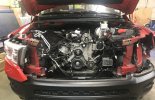 5B5E66DA-23C2-4B66-A0C0-F215DCCFE716.jpeg151.1 KB · Views: 320
5B5E66DA-23C2-4B66-A0C0-F215DCCFE716.jpeg151.1 KB · Views: 320 -
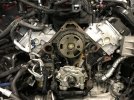 669A6880-1D89-4F2C-82CC-2C648CFC8C5C.jpeg189.1 KB · Views: 315
669A6880-1D89-4F2C-82CC-2C648CFC8C5C.jpeg189.1 KB · Views: 315 -
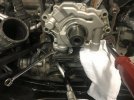 2DA5FCB0-6F1F-44AA-8CEC-90EE8ECDE688.jpeg129.8 KB · Views: 306
2DA5FCB0-6F1F-44AA-8CEC-90EE8ECDE688.jpeg129.8 KB · Views: 306 -
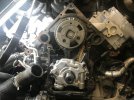 40720C36-A920-4C4A-8015-21DFE2A50AF5.jpeg156.6 KB · Views: 308
40720C36-A920-4C4A-8015-21DFE2A50AF5.jpeg156.6 KB · Views: 308 -
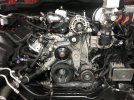 D048035E-C405-4C7F-A904-B403A2BFF369.jpeg178.5 KB · Views: 307
D048035E-C405-4C7F-A904-B403A2BFF369.jpeg178.5 KB · Views: 307
Last edited:










